Meuterer
Preparazione del gioco
Con il commando /join si possononoire da 3 a 4 giocatori. Con/start la partita ha inizio. Alternatively, you can use the Strumento di gioco!
The gioco
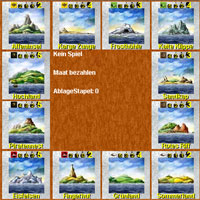
Everything actually seems quite peaceful on the merchant ship. With the holds full, the captain heads for the next island to sell goods there. But appearances are deceptive, because the mutineer has something completely different in mind: together with the cabin boy, he tries to overthrow the captain in order to take the helm himself. Can the captain rely on his loyal mate?
The players try to collect as many points as possible in each round by cleverly selling their goods on the islands and mutinies on board.
The characters
Captain
{ 2}The captain is always the starting player. He determines the destination of the round unless he is deposed by a mutiny. At his side is the faithful mate.
The faithful mate

The mate stands by his captain in the event of a mutiny. His presence alone counts for a sword for the captain. The mate receives one point as the minimum wage, plus the points donated by the captain (see "Paying the mate"); even in the event that there was no mutiny.
Mutiners
 < p> The mutineer tries to become the new captain through a mutiny. He is supported by the cabin boy. If the mutiny succeeds, he chooses the new destination port and becomes captain in the next round. If the mutiny fails, the mutineer gets nothing in this round.
< p> The mutineer tries to become the new captain through a mutiny. He is supported by the cabin boy. If the mutiny succeeds, he chooses the new destination port and becomes captain in the next round. If the mutiny fails, the mutineer gets nothing in this round. Cabin boy
{5 }The cabin boy supports the mutineer. In the event of a successful mutiny, the cabin boy receives two victory points as a reward. If there is no mutiny or if it fails, he goes away empty-handed.
Mercante (merchant)

The dealer has advantages when selling goods: if there is a tie for most goods on an island, the dealer still always gets the highest price.
Loadmaster

The loadmaster is valuable for the next round: he gets three more cards to choose from when filling up his hand . However, he is only allowed to keep five.
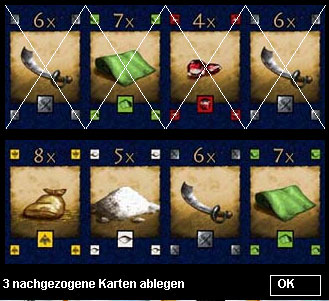
The crossed out cards show the loadmaster's remaining hand cards. He must discard the specified number of cards from the remaining ones so that he has five again. To do this, he clicks on the cards he wants to hand over and confirms with "OK".
Svolgimento

In the middle of the playing field is the game display, from which you can see the following:
- Current round
- Current player
- Current action
- Maat points offered
- Number of cards in the draw pile, as well as the top card of the Discard pile
Pay mate

One player is captain . At the beginning of each round he decides how many additional victory points he will give to the mate in this round in the event of successful support. These points are deducted from the captain's island points gained.
Offer goods

In each round the players can try to sell goods to the natives on 1-2 islands. The active islands have a brown frame instead of the gray one.
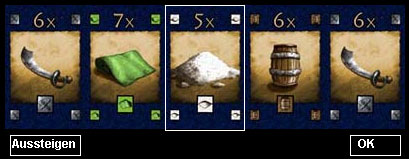
When it's your turn, you get a selection window with your hand cards, select one that you want to play and confirm your selection with "OK".
If you want to get out, select the "Get out" button (no card must be selected!)
Select character
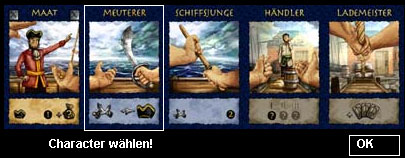
If you have selected "Get out", the selection window for the characters appears (see above). Here you select a role in the same way and confirm with "OK".
Set destination

Primarily, the captain sets the destination for the next round. Once he gets out, the number of cards he has left in his hand determines the destination of the journey. The corresponding island is marked with the brown captain's sign. In the picture, the captain still had one card left in his hand, meaning the ship would move one island from Ice Rock to Sand Cape. Attention: you can only sell on the target island from the next round!
If the mutineer is in play, the expected destination is marked with the blue mutineer shield, also depending on the number of cards in the mutineer's hand.
When selecting the target, the number of cards remaining in your hand before playing additional sabers applies!
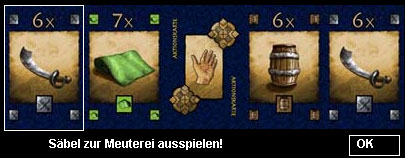
If the mutineer has been chosen, each player involved in the mutiny can now play sabers from their hand in turn - starting with the captain - to influence the outcome of the mutiny.
The sabers already laid out in the goods phase are added to those still laid out now. The following applies:
- The cabin boy's sabers count as the mutineer
- The mate's sabers count as the captain's
If the mutineer and cabin boy together have more or the same number of sabers as the captain and the mate (the mate himself also counts as 1 saber!), the mutineer succeeds and the mutineer becomes the new captain. The ship sails to the island that was chosen by the mutineer based on his remaining cards in his hand. As a reward, the mutineer receives the number of victory points of this island (top right on the island map).
The cabin boy receives two points, the captain and mate receive nothing.

If the mutiny fails, the ship sails to the island that was chosen by the captain based on his remaining cards in his hand. As a reward, the captain receives the number of victory points for this island (top right on the island map) - minus the mate points donated.
The mutineers and cabin boys go away empty-handed. < /p>
If there is no mutiny, the captain and mate still receive their points.
Selling goods

On most islands you can only sell exactly one type of raw material (here in ice rocks, for example, only rubies). On the two islands with the "?" All types can be sold. Any number of goods of one type can be sold on an island. Basically, only players who have the majority of goods on an island can sell goods. The sale brings the following victory points:
- If you alone have the majority, you get the full number of points (here six)
- If two players have the majority, both get it the average number of points (here 4)
- If three players have the majority, all three receive the lowest number of points (here 3)
If all four players have the same number Went to an island and everyone came away empty-handed. If a player has chosen the dealer, he always gets the highest number of points in the event of a tie.
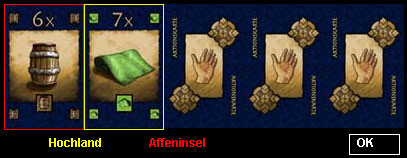
The goods are dealt in turn, starting with the captain, sold. You get the sales window with your goods laid out and you can now choose which goods you want to sell on which island.
You have to pay attention to the colors: click on a good once , it gets a yellow frame, if you click twice it gets a red one, and another click removes the frame again. The frame color is analogous to the color of the island name.
In the picture you mark the raw materials that you want to sell in "Highlands" with a yellow frame, the raw materials for Monkey Island need one red frame. Here too you confirm the selection with "OK"
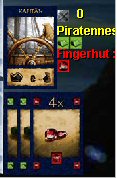
For each player it is shown which goods they have on which island sold; Here two cloths are sold in "Pirate's Nest" and a ruby in "Foxglove".
The sale of goods is an important, tactical one Medium: you can, for example, split your sales. For example, if you have played five grains, you can sell three of them on island A (? island) and two of them on island B (grain island). Provided, of course, that you hold the majority.
The number of goods cards varies depending on the type. The frequency of their occurrence is indicated on the top of each commodity card.
Fine del gioco
The game ends with 3/4 players after 9/8 rounds.
Opzioni
dm
If all four players sell the same number of goods, the dealer also comes away empty-handed.

